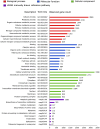Transcriptome analysis of Phytophthora cactorum infecting strawberry identified RXLR effectors that induce cell death when transiently expressed in Nicotiana benthamiana
- PMID: 38855473
- PMCID: PMC11157022
- DOI: 10.3389/fpls.2024.1379970
Transcriptome analysis of Phytophthora cactorum infecting strawberry identified RXLR effectors that induce cell death when transiently expressed in Nicotiana benthamiana
Abstract
Phytophthora cactorum is a plant pathogenic oomycete that causes crown rot in strawberry leading to significant economic losses every year. To invade the host, P. cactorum secretes an arsenal of effectors that can manipulate host physiology and impair its defense system promoting infection. A transcriptome analysis was conducted on a susceptible wild strawberry genotype (Fragaria vesca) 48 hours post inoculation with P. cactorum to identify effectors expressed during the early infection stage. The analysis revealed 4,668 P. cactorum genes expressed during infection of F. vesca. A total of 539 secreted proteins encoded by transcripts were identified, including 120 carbohydrate-active enzymes, 40 RXLRs, 23 proteolytic enzymes, nine elicitins, seven cysteine rich proteins, seven necrosis inducing proteins and 216 hypothetical proteins with unknown function. Twenty of the 40 RXLR effector candidates were transiently expressed in Nicotiana benthamiana using agroinfiltration and five previously unreported RXLR effector genes (Pc741, Pc8318, Pc10890, Pc20813, and Pc22290) triggered cell death when transiently expressed. The identified cell death inducing RXLR effectors showed 31-66% identity to known RXLR effectors in different Phytophthora species having roles in pathogenicity including both activation and suppression of defense response in the host. Furthermore, homology analysis revealed that these cell death inducing RXLR effectors were highly conserved (82 - 100% identity) across 23 different strains of P. cactorum originating from apple or strawberry.
Keywords: RNA-Seq; agroinfiltration; disease resistance response; host-pathogen interaction; oomycete.
Copyright © 2024 Ghimire, Gogoi, Poudel, Stensvand and Brurberg.
Conflict of interest statement
The authors declare that the research was conducted in the absence of any commercial or financial relationships that could be construed as a potential conflict of interest.
Figures



Similar articles
-
Transcriptomic analysis of the phytopathogenic oomycete Phytophthora cactorum provides insights into infection-related effectors.BMC Genomics. 2014 Nov 18;15(1):980. doi: 10.1186/1471-2164-15-980. BMC Genomics. 2014. PMID: 25406848 Free PMC article.
-
Atypical RXLR effectors are involved in Phytophthora cactorum pathogenesis.aBIOTECH. 2025 Jan 27;6(1):50-62. doi: 10.1007/s42994-025-00198-4. eCollection 2025 Mar. aBIOTECH. 2025. PMID: 40060176 Free PMC article.
-
Expression of the GAF Sensor, Carbohydrate-Active Enzymes, Elicitins, and RXLRs Differs Markedly Between Two Phytophthora cactorum Isolates.Phytopathology. 2019 May;109(5):726-735. doi: 10.1094/PHYTO-04-18-0136-R. Epub 2019 Apr 5. Phytopathology. 2019. PMID: 30412010
-
Comparative Transcriptome Analysis Reveals Novel Candidate Resistance Genes Involved in Defence against Phytophthora cactorum in Strawberry.Int J Mol Sci. 2023 Jun 29;24(13):10851. doi: 10.3390/ijms241310851. Int J Mol Sci. 2023. PMID: 37446029 Free PMC article.
-
Comparative Analysis of Host-Associated Variation in Phytophthora cactorum.Front Microbiol. 2021 Jul 2;12:679936. doi: 10.3389/fmicb.2021.679936. eCollection 2021. Front Microbiol. 2021. PMID: 34276614 Free PMC article.
References
-
- Ali A., Kumar R., Mazákova J., Maňasová M., Zouhar M., Pánek M. (2022). Evaluation of the ability of seven active ingredients of fungicides to suppress Phytophthora cactorum at diverse life stages, and variability in resistance found among isolates. J. Fungi 8, Article 1039. doi: 10.3390/jof8101039 - DOI - PMC - PubMed
LinkOut - more resources
Full Text Sources

